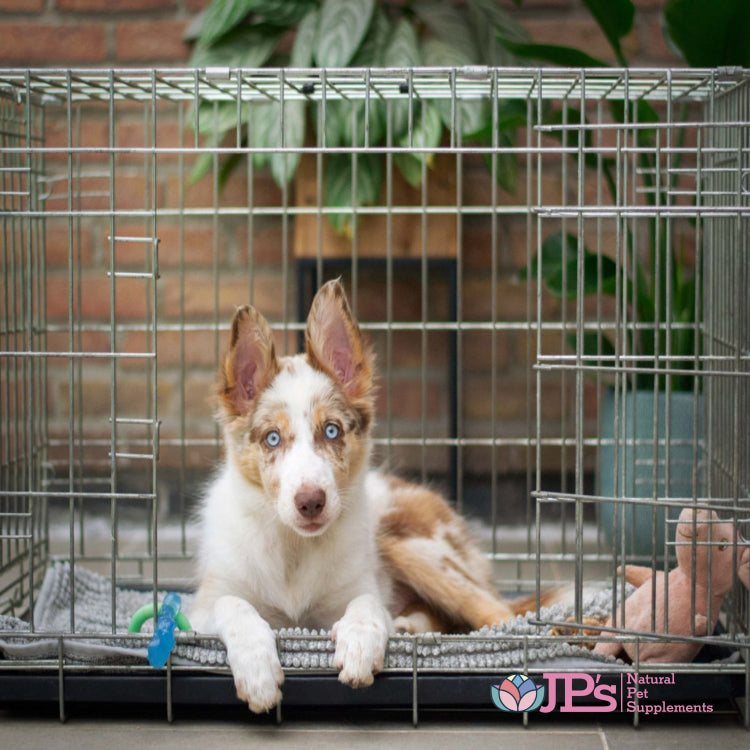What is crate training for dogs?
Crate training dogs can be a good training tool if used correctly and not abused. As a dog trainer, I've noticed that when I mention a crate during a puppy consultation, some owners look horrified, while others love crate training and swear by it, and still others cannot imagine putting their puppy in a crate. This is a very controversial topic. What do we do with a baby at night to keep them safe? We put them in a cot that looks remarkably like a crate. I brought my dog, Charlie, up in a crate when he was a puppy, but this was just my choice. I also had a playpen around the crate, with the crate door left open, and this worked very well for my dog Charlie because he got used to the crate with the playpen around it. Crate training a puppy, or a dog, includes teaching them to associate their crate with safety and security. The hope is that the crate becomes the place to go when your pup feels overwhelmed or sleepy. Puppies need undisturbed rest and sleep time, as this is crucial for their well-being during training. Regardless of everything you have read or heard, you should consider the pros and cons of crate training and whether it is something that you believe is right for you and your puppy.
Pros of crate training.
One effective way to toilet train your puppy is by using a crate, as puppies have weak bladders until about 16 weeks old (3 months old). They must pee several times a day, and they have to learn to do their business outside and not indoors. The crate is a terrific way forward for teaching them toilet training. When your puppy wakes up from sleeping, you can take them outside for a toilet. When crate training your pup, spend about 10-30 minutes in the crate, then try again immediately, taking them outside for a toilet break. This helps to set your pup up for success. (If your pup is sleeping, leave them until they wake up.) Puppies or dogs will consider their crate as a den and will tend not to urinate or defecate in their crate. This does not mean you can leave your puppy or dog for hours on end in a crate. Ensure your puppy or dog has multiple opportunities to go to the toilet, such as after playing, sleeping, and eating. Adult dogs should not be left any longer than four hours in a crate in the daytime; any longer than this is not looking after your dog’s well-being.

Puppy space.
Everyone in a family has his or her own space, and it is only fair that your puppy has a space to be calm on their own. A crate can do just that. They will have a safe, quiet place to lie down and relax away from the noise of a typical day.
Helps prevent destructive behaviour.
Dogs and puppies often exhibit unusual and destructive behaviours, such as inappropriate chewing (especially when puppies are teething), which is a common issue with puppies. The crate helps to keep them safe from danger if they cannot be supervised by you when you are busy.
Separation anxiety.
If your puppy is brought up correctly and associates the crate with good stuff that happens when they are in the crate, such as treats and toys, separation anxiety shouldn’t be a problem in the future for your puppy, because you would have built your puppies confidence up slowly to having some time alone away from you in their crate. It is important to note that if your dog is already suffering from separation anxiety, you should never confine them in a crate, as this would make the situation worse. In this case, the best thing you can do is contact a dog behaviourist who can give you the correct guidance to follow to solve the problem.
Dogs that need cage rest after surgery.
Another good reason to get your dog used to crate training is that you never know in the future if your dog could get injured; they may have to spend a few days in a veterinary clinic, and they would have to be inside a crate or cage for their safety. Your dog will be less stressed, and you may need to continue crate rest when they return home.
Safe transportation and family adventures.
A dog that is familiar with its crate will travel comfortably and safely by car and feel relaxed. The reason many places restrict dog access is that free-roaming untrained dogs create liability issues. When you show that your dog is well trained then most facilities will let you bring your dog along for the adventure. It makes it much easier to bring your dog along for a family outing, trip, or even longer holidays when they are used to travelling in a crate. You may even have to crate them in your hotel room if you go for dinner. This is much better than leaving your dog behind at home if they are content being in a crate for a brief time.
Natural instincts.
Dogs have a particular affection for confined spaces; they like going under beds, under coffee tables, behind settees. Giving them a safe place can come in handy, especially around bonfire night, if your dog feels anxious or frightened.

Socialisation.
A crate is useful for socialisation exercises if you have a dog that is not keen on being around people it does not know. When there are lots of children running around your home, or you have guests having a meal, you can prevent overexcitement by bringing your pup back to their crate. You can even use this tool to prevent unwanted behaviours, such as begging at the table when you are eating. The crate comes in handy until you have your training skills under control.
Cons of crate training.
Some owners do not use the crate correctly; they use the crate as a punishment if the puppy has done something wrong, thinking they will learn by putting them in the crate. This can be very damaging for your puppy or dog. The crate should never be used as a punishment.
Away from home working.
Your dog or puppy should never be left for extended periods each day in a crate. Consider hiring a dog walker or pet sitter to break up your dog’s day, providing them with socialisation and exercise. A crate should have enough room to turn around, stand up, and lie down comfortably.
Safety.
Your first goal should be to ensure the crate is put together properly. A crate constructed improperly could result in it collapsing on your puppy or dog causing injury. Always remove your puppy’s or dog’s collar to prevent accidental choking. Your dog or puppy’s collar could get stuck on the door, which could result in strangulation. Make sure the crate is not left in direct sunlight, such as by a window. Make sure your dog has access to water.
The crate can leave your dog traumatised.
If your dog keeps having bad experiences with its crate, this could leave your dog traumatised and anxious, and unable to trust you. One major disadvantage of crate training is that it can be ineffective if you're not doing it correctly, such as simply putting your dog in a crate when you're leaving the house. This can become a trigger for your dog and cause stress. Leaving your dog for extended periods while you are working 8 hours a day can lead to your dog suffering both psychologically and physically from being crated for too long. This can result in separation anxiety, eating disorders, depression, or hyperactivity, along with muscle atrophy, obsessive compulsive behaviours, like licking and chewing, and even the inability to form a meaningful bond with their owner. Crating for long hours during the day denies dogs from expressing their most basic natural needs, including stretching, moving around, exploring their environment, and most importantly, going to the toilet. Your dog should only be crated 4 hours maximum in the daytime. Your dog will need a walk, a toilet break, and some kind of brain enrichment, such as a stuffed food Kong.
Finally.
Remember to slowly build your puppy or dog’s confidence up in their crate. Place the crate in a frequently used area, like the family room. Make the crate comfortable with their bed inside. Make sure the crate door is securely fastened open, so it won’t hit your puppy or dog and frighten them. When they are coming and going out of the crate, encourage your pup or dog to enter the crate by tossing some treats inside the crate. If they refuse to go all the way inside the crate at first, that’s ok, don’t ever force them to enter. Just continue tossing treats into the crate until they walk in calmly. You can even use a toy; make everything positive about the crate. This step may take time, or as long as several days. Have some enrichments ready for your crate training, such as a food-stuffed Kong. This way, if your puppy or dog does go in the crate, you can offer the Kong, but leave the door open until they're happy and confident inside. I have clients today who have crate trained their dog from a puppy, and they leave the crate door open, and their dogs are still happy to go in the crate.
Visit my blog posts on JP's Natural Pet Supplements for more dog training and behavioural advice.



















Leave a comment (all fields required)